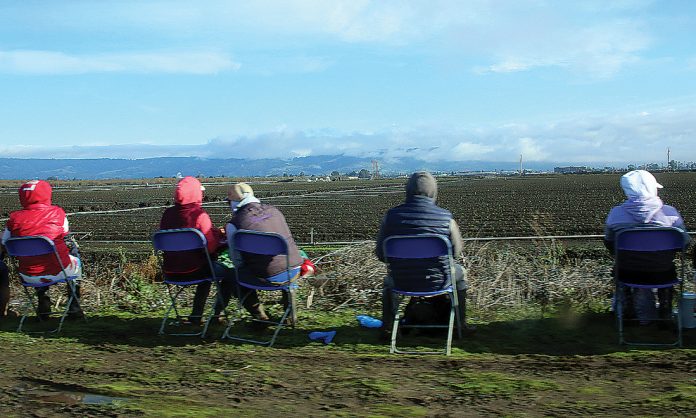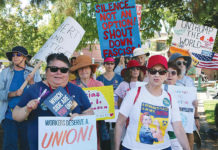WATSONVILLE—The demographics of Santa Cruz County’s novel coronavirus cases now mirror those at the state and national level, raising concerns about the county’s response to increasing numbers in Watsonville.
Though cases have remained relatively low compared to other counties around the state, Watsonville and its large Latinx community—80 percent of the population in the county’s southernmost city—has been hit the hardest during the Covid-19 pandemic.
As of Thursday, there were 106 known active cases in the county and 337 cases overall. More than half (184) of the county’s cases have been identified in the Watsonville area, and Latinx residents make up 55.49% of the county’s cases despite being only 33.5% of the county’s population.
At the state level, Latinx residents account for roughly 56% of Covid-19 cases despite being only 38.9% of California’s population. And nationally the COVID Tracking Project—a volunteer-led organization started by The Atlantic—claims that there is a racial/ethnic disparity in nearly all of the 49 states or territories who report their race and ethnicity data. Thirty-seven of those states or territories are seeing their Latinx residents being disproportionately affected by Covid-19.
In Nebraska, where Latinx residents account for only 11% of the population, that group makes up 62% of all Covid-19 cases, many of which have been traced back to meatpacking plants where laborers work shoulder-to-shoulder for hours. Other parts of “flyover country” such as Idaho, Iowa, Kansas, Kentucky, Oklahoma and Wisconsin have also seen their Latinx populations disproportionately impacted.
Many coastal states, too, have not had much success in protecting their Latinx populations. That population makes up 13% of Oregon residents but accounts for 40% of the state’s Covid-19 cases. New York does not report race/ethnicity data for confirmed cases, but has reported that Latinx residents have accounted for 27% of the state’s deaths—more than any other demographic in the state—despite being only 19% of the population.
The Centers for Disease Control and Prevention has said that there are numerous factors as to why minorities are being disproportionately affected, including living conditions, work circumstances, underlying health conditions and lower access to health care. And Santa Cruz County health officials have confirmed that information during now-discontinued weekly press conferences.
In a press conference on June 11, Deputy County Health Officer David Ghilarducci said that the county’s residents of color have taken the brunt of the pandemic because many work in industries that were deemed essential by county and state orders such as grocery stores, gas stations and hardware stores.
In Watsonville, essential jobs are the lifeblood of the local economy. Industries such as farming, construction, maintenance and food service and preparation, as well as manufacturing, retail and transportation far outnumber tech, management and other white-collar industries that were able to make the switch to at-home work when Covid-19 started to spread. According to Data USA, only a quarter of the occupations in Watsonville are in industries such as office and administrative support, business and financial operations and architecture and engineering.
Watsonville City Councilman Felipe Hernandez said that the city’s economic profile, combined with the low wages and minimal benefits that are found in many of those industries, have created a dangerous landscape for Watsonville’s workers. While some industries closed their offices and moved online, many in Watsonville continued reporting to work despite health concerns because they had to pay bills.
“Everywhere you’re most likely to get infected with Covid, [Latinx residents] are there,” Hernandez said. “Unfortunately, they’re there for 8-12 hours every day for low wages, no paid sick days, no healthcare, no option to work from home. There is an underlying issue and it’s being illustrated right now.”
Cases in Watsonville jumped after four Covid-19 ‘clusters’ related to Mother’s Day celebrations arose. Since then, the county and city have picked up their outreach and education efforts through media campaigns specifically targeted at Pajaro Valley residents. But cases continue to climb in Watsonville despite those efforts, and the age range of those positive cases has shifted into the younger population—now people 18-34 make up the largest amount (106) of cases.
Hernandez said he believes the rise in cases and shift in age are a direct result of Watsonville’s young people returning to the workforce as shelter-in-place restrictions have been peeled back over the last month.
County health officials, however, have attributed the increases to various factors, including holidays, group gatherings, reopenings and increased testing.
County data specifying where a person acquired the case is still slim, as the majority of known cases have not been publicly linked to a specific profession. Only farm and agriculture (32), health care workers (26) and first responders (6) have been separated from the all-encompassing “other” category on the county’s website.
County health officials have said they will expand the profession category when there are enough cases in other professions. Officials have also said those numbers do not indicate where a person contracted the virus—it is merely where a person works.
Santa Cruz County Health Officer Gail Newel at a press conference Thursday said very few cases are acquired while employees are working.
“Some of the cases are acquired in the breakroom at work, where people gather closely together and take their face coverings off to eat and drink and are often too close to other employees,” she said. “Those social gatherings are putting the greatest number of people at risk… Gatherings in the work setting, but not the professional setting, per se. In the breakroom or outside in the parking lot, that’s where it seems where people are not physical distancing, not wearing their face coverings and being too close to each other.”












